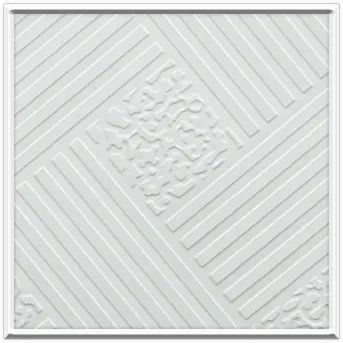9 月 . 17, 2024 07:07 Back to list
Ceiling Grid Main Tee - Durable and Reliable Ceiling Solutions
Understanding Ceiling Grid Main Tee A Key Component of Suspended Ceilings
In modern architectural design and construction, suspended ceilings have emerged as a popular choice for both aesthetic and practical reasons. A critical element in this system is the ceiling grid, particularly the main tee. This article delivers an overview of the ceiling grid main tee, its importance, installation process, and benefits, helping to elucidate why it is a staple in suspended ceiling construction.
The main tee serves as the backbone of the ceiling grid system. It is a long, linear structural element, typically made from galvanized steel or aluminum, which forms the horizontal framework to which ceiling tiles or panels are attached. The main tee is distinguished by its T-shaped cross-section, from which it derives its name. These components intersect to create a grid configuration, providing robust support for the ceiling tiles while allowing easy access to the space above, where electrical wiring, plumbing, and HVAC systems often reside.
Installation Process
The installation of a ceiling grid main tee requires precision and planning. First, the height at which the ceiling will be suspended is established, often based on factors like lighting, insulation, and aesthetic preferences. Once determined, a reference line is marked around the perimeter of the room.
Next, the main tees are installed at specified intervals, typically 4 feet apart, depending on the size and type of ceiling tiles being used. These tees are supported by shorter cross tees that extend perpendicularly, creating a grid. To ensure stability and level alignment, each main tee is fastened securely to the structure above, usually with wire hangers. This meticulous process ensures the grid can adequately support the weight of the ceiling tiles, enhancing safety and longevity.
ceiling grid main tee

Benefits of Ceiling Grid Main Tee
The main tee offers numerous advantages in the construction of suspended ceilings. Firstly, its design allows for flexibility and modularity, meaning that tiles can be easily replaced or removed. This access is invaluable for maintenance and repairs of the systems hidden above the ceiling, making the space functional without the need for demolition.
Additionally, the use of a ceiling grid main tee can help improve acoustic performance. The spaces between the tiles can accommodate sound-absorbing materials, aiding in noise reduction, which is crucial in environments such as offices, schools, and hospitals.
Aesthetic appeal is another significant benefit of employing a main tee ceiling grid. It allows for uniformity and a clean finish, capable of supporting a variety of ceiling tiles which can enhance the overall design of a space. From colored tiles to textures, the options are vast, allowing architects and designers to exercise creativity while meeting specific functional demands.
In conclusion, the ceiling grid main tee is an essential component in the realm of suspended ceiling construction. Its structural integrity, ease of installation, and myriad benefits for maintenance and aesthetics make it a fundamental choice for contemporary architecture. As the demand for versatile and attractive building solutions increases, the main tee remains a steadfast solution catering to both functionality and form.
-
Revolutionizing Interior Design with Ceilings t grid Suspended SystemNewsOct.29,2024
-
Revolutionizing Ceiling Design with ceiling access panel with Gypsum Tile WaterproofNewsOct.29,2024
-
Revolutionizing Interior Design with PVC Gypsum Ceiling: A Comprehensive GuideNewsOct.29,2024
-
Elevating Interior Design with High quality Mineral Fiber Ceiling TilesNewsOct.29,2024
-
Revolutionizing Interior Design with PVC Gypsum Ceiling: A Comprehensive GuideNewsOct.29,2024
-
Elevating Interior Design with High-Quality Mineral Fiber Ceiling Tiles: A Comprehensive GuideNewsOct.29,2024







